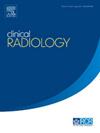AI bone lesion classifier with sensitivity-driven optimization for radiographs
IF 1.9
3区 医学
Q2 RADIOLOGY, NUCLEAR MEDICINE & MEDICAL IMAGING
引用次数: 0
Abstract
Aim
This study aims to develop a deep learning classifier for detecting primary bone lesions on radiographs, emphasizing high sensitivity while maintaining practical clinical usability.
Material and Methods
Radiographs of the upper and lower extremities were reviewed by board-certified radiologists and categorized into two groups: “Normal” (without bone lesions) and “Abnormal” (with bone lesions). The final dataset comprised 1,177 radiographs from 310 patients, including 547 abnormal and 630 normal cases.
The MobileNetV2 architecture was trained with a sensitivity-driven approach designed to minimize false negatives. Model performance was evaluated on a hold-out test set, and attention maps were generated to enhance interpretability and visualize regions contributing to the model's decisions.
Results
The model was tested on a naïve hold-out test set. The results received on the test set: sensitivity of 96.6%, specificity of 82.2%, accuracy of 87.9%, area under the curve (AUC) of 0.94, and 95% confidence interval of [0.901, 0.981].
Conclusion
The study demonstrates the feasibility of deploying AI-based tools for radiographic detection of bone tumors with a sensitivity-focused optimization. These tools have the potential to enhance diagnostic accuracy, reduce diagnostic delays, and support population health initiatives.
基于灵敏度驱动优化的人工智能骨病变分类器。
目的:本研究旨在开发一种用于x线片上原发性骨病变检测的深度学习分类器,在保持临床实用性的同时强调高灵敏度。材料和方法:上肢和下肢的x线片由委员会认证的放射科医生审查,并分为两组:“正常”(无骨损伤)和“异常”(有骨损伤)。最终的数据集包括来自310名患者的1177张x线片,其中包括547例异常病例和630例正常病例。MobileNetV2架构采用灵敏度驱动的方法进行训练,旨在最大限度地减少误报。在hold-out测试集上评估模型性能,并生成注意图以增强可解释性和可视化有助于模型决策的区域。结果:模型在naïve hold-out测试集上进行了测试。测试集结果灵敏度为96.6%,特异度为82.2%,准确度为87.9%,曲线下面积(AUC)为0.94,95%可信区间为[0.901,0.981]。结论:该研究证明了应用基于人工智能的工具进行骨肿瘤放射检测的可行性,并进行了敏感性优化。这些工具有可能提高诊断准确性,减少诊断延误,并支持人口健康行动。
本文章由计算机程序翻译,如有差异,请以英文原文为准。
求助全文
约1分钟内获得全文
求助全文
来源期刊

Clinical radiology
医学-核医学
CiteScore
4.70
自引率
3.80%
发文量
528
审稿时长
76 days
期刊介绍:
Clinical Radiology is published by Elsevier on behalf of The Royal College of Radiologists. Clinical Radiology is an International Journal bringing you original research, editorials and review articles on all aspects of diagnostic imaging, including:
• Computed tomography
• Magnetic resonance imaging
• Ultrasonography
• Digital radiology
• Interventional radiology
• Radiography
• Nuclear medicine
Papers on radiological protection, quality assurance, audit in radiology and matters relating to radiological training and education are also included. In addition, each issue contains correspondence, book reviews and notices of forthcoming events.
 求助内容:
求助内容: 应助结果提醒方式:
应助结果提醒方式:


